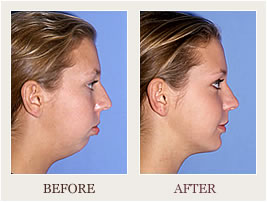
The discovery of BOTOX® shares something with the discoveries of electricity and the Internet: as time goes on, more and more uses are found for all three.
In this case, a small test on 11 receding chin patients treated with BOTOX® was done at the Keck School of Medicine at the University of Southern California (USC) in Los Angles.
The study was recently printed in JAMA Facial Plastic Surgery, a professional magazine for cosmetic plastic surgeons.
That study found that some patients have a receding chin because an overactive facial muscle pulls the chin and jawbone back.
Result? The profile looks weak and makes the patient’s facial profile look unbalanced like in the above before picture.
The usual cosmetic procedures for the last 40 years have been adding horseshoe-shaped implants made of solid medical grade silicone to the front of the patient’s jawbone.
Yet another technique known as Genioplasty surgically saws through the jaw and reattaches it in a more forward position. (Look at some more before and after pictures of standard chin augmentation patients.)
BOTOX® now has dozens of uses in addition to its famous wrinkle-zapping ability. BOTOX®, Dysport, and Xeomin® work by preventing signals from nerve cells reaching muscles and is known medically as botulinum toxin which is injected in extremely small concentrations. (But don’t worry, it won’t give you a case of botulism!)
According to the study’s lead author, Amy Hsu, M.D., a Beverly Hills facial plastic and reconstructive surgeon, some receding chin patients have an overactive facial muscle, too.
“These patients have a hyperactive mentalis muscle. So, chin augmentation with filler or implants still does not always solve the aesthetics of a receding chin because that muscle is still contracting in the augmented area,” says Dr. Hsu.
All eleven patients received one session of BOTOX® injected into the patients’ mentalis muscles. According to before and after treatment photos, the chin projection increased in five patients and decreased in six patients who had too much chin.
But don’t look for cosmetic plastic surgeons to offer the procedure anytime soon.
Results on only eleven patients are considered in medicine far too small to be meaningful, so larger studies will be organized and conducted in the coming months and probably, years.

